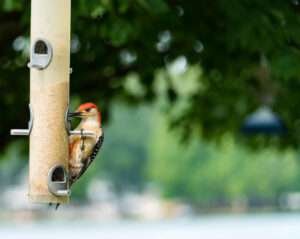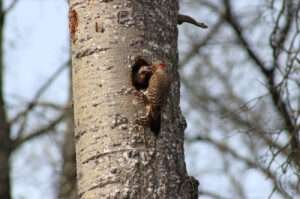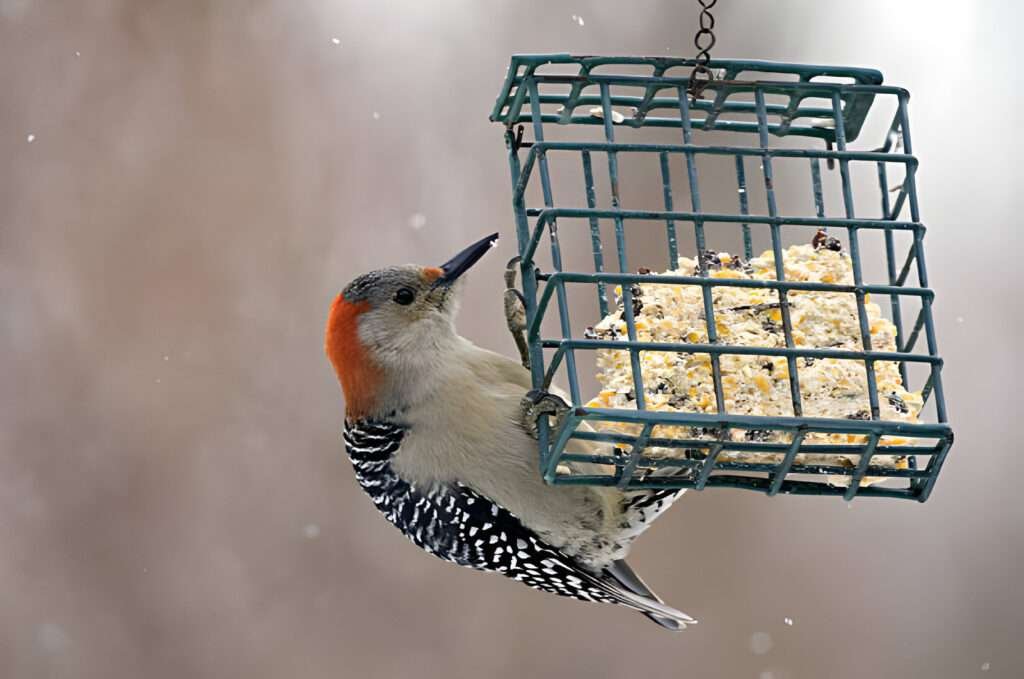The Pileated Woodpecker is the largest woodpecker in Michigan. It features a striking red crest and black body.
Michigan’s woodlands are a symphony of avian activity, among which the woodpecker takes a starring role. The Pileated Woodpecker, a species endemic to North America, resonates with a distinctive drumming on trees. Bird enthusiasts treasure this creature for its ecological role and charismatic appearance.
With its powerful beak, the Pileated Woodpecker carves out large cavities in search of ants and other insects. These cavities later serve as vital nesting sites for various wildlife. Its presence indicates a healthy forest ecosystem. Understanding the habitat and behaviour of Michigan’s woodpeckers enhances our appreciation of the state’s natural diversity and the importance of conservation efforts.
Identification
Welcome to the colourful world of Michigan’s woodpeckers!
These birds splash the forests with their vibrant hues and rhythmic pecking. Let’s delve into the eye-catching details that make these creatures stand out. Spotting a woodpecker in Michigan becomes a game of ‘I Spy’ when you know what to look for!
Physical Characteristics
Michigan woodpeckers come in various sizes, but they share some common traits. To identify them, observe their strong beaks, which are ideal for drilling into wood.
- Sturdy bodies with short legs and sharp claws
- Stiff tail feathers, helpful for support against tree trunks
- Zebra-like stripes or spots in black and white
- Chisel-like beaks that chip away bark and wood
| Species | Size | Colour |
|---|---|---|
| Downy Woodpecker | Small | Black and white |
| Hairy Woodpecker | Medium | Black and white with a longer beak |
| Red-bellied Woodpecker | Medium to Large | Black and white with red cap |
| Pileated Woodpecker | Large | Black with white stripes and red crest |
Distinctive Features
Unique markers help differentiate one species from another. Notice these distinctive features:
- Red patches: Often found on the heads of males
- Sounds: Each has a unique call and drumming pattern
- Flight: Recognize their undulating flight pattern
These keen identifiers make it a joy to discover different woodpecker species across Michigan’s diverse habitats.
Species In Michigan
Majestic forests in Michigan harbour various species of woodpeckers. These intriguing birds captivate nature lovers with their pecking sounds and vibrant patterns. They play a critical role in the ecosystem, aiding pest control and forest health. Michigan is proud to present a diverse array of woodpecker species, from the most familiar backyard visitors to rarer gems requiring a keen eye. Below, you will find details on the common and rare woodpeckers beautifying Michigan’s landscapes.

Common Woodpeckers
- Downy Woodpecker: The smallest and most widespread in Michigan.
- Hairy Woodpecker: Looks like the Downy but is larger with a longer beak.
- Red-headed Woodpecker: Noted for its striking red head and white body.
- Red-bellied Woodpecker: Recognizable by its red nape and streaked belly.
- Pileated Woodpecker: The largest, resembling a crow with a red crest.
- Northern Flicker: Known for its spotted belly and distinct call.
Rare Woodpeckers
| Species | Description | Habitat |
|---|---|---|
| Black-backed Woodpecker | Black with white spots, prefers burned forests. | Boreal woodlands |
| Red-cockaded Woodpecker | Small, white cheek patches, endangered species. | Pine forests |
| American Three-toed Woodpecker | Barred patterns and three-toed feet, rare visitor. | Coniferous forests |
Role In Ecosystem
The forests of Michigan echo with the drumming of woodpeckers, each tap serving a purpose. Their role in the ecosystem extends far beyond their distinctive calls. These birds are ecological linchpins, from trees’ well-being to prey populations’ dynamics.
Effect On Tree Health
Woodpeckers play a vital role in maintaining tree health throughout Michigan’s forests. They peck at tree bark searching for insects and larvae, which can help control tree pests. These activities can sometimes be mistaken for harming the trees, but often, woodpeckers target already sick or infested trees.
By removing harmful insects, woodpeckers help reduce the spread of tree diseases. Their presence signals a natural pest management system harmonising with the forest’s health needs. Woodpeckers also create cavities essential for their nests, which later serve as shelters for other species, contributing to a biodiverse habitat.

Prey Population Control
Predatory instincts of woodpeckers keep the insect populations in check. They feast on a diet rich in beetles, ants, caterpillars, and other invertebrates, which balances these prey populations.
Thinning out excess prey numbers, these birds prevent outbreaks that could damage the ecosystem. Their foraging habits are crucial for safeguarding tree life and cultivating healthy flora. The woodpecker’s appetite supports a thriving, balanced ecosystem.
Conservation Status
The conservation status of Michigan’s woodpeckers reflects their ability to thrive in their habitat. A close look at their current situation reveals various factors that impact these captivating birds. Understanding the threats they face and the conservation efforts to protect them is vital. These elements help us ensure a future where woodpeckers continue to enliven Michigan’s forests.
Threats
Woodpeckers in Michigan are up against several challenges. Below are the key dangers they encounter:
- Habitat loss: Due to urban expansion and deforestation.
- Climate change: Altering their natural environment rapidly.
- Pesticide use: Reducing their insect food sources significantly.
- Competition for nesting spaces from other birds and animals.
Conservation Efforts
To combat these threats, various conservation measures are now in effect. Key initiatives include:
- Creating protected areas to safeguard natural habitats.
- Implementing sustainable forestry to maintain ecosystem balance.
- Regulating pesticides to ensure food sources for woodpeckers remain abundant.
- Promoting community awareness programs about woodpecker conservation.
These efforts are essential in maintaining a stable population of woodpeckers in Michigan. With continued focus, Michigan’s woodpeckers can flourish for generations to come.
Interaction With Humans
Woodpeckers in Michigan are a remarkable sight. Their interactions with humans are diverse and can significantly influence our environment. Understanding these relationships helps us coexist with these fascinating birds.
Impact On Agriculture
Woodpeckers play a unique role in Michigan’s agriculture. They help control insects that may harm crops. However, they sometimes peck at wooden structures causing damage to farm buildings. Farmers implement bird-friendly practices to minimize this harm while gaining pest control benefits.
Human-woodpecker Conflict
In urban areas, woodpeckers drumming on homes can be a nuisance. This behaviour, mainly in spring, marks their territory and attracts mates. Some woodpecker species might drill into siding, seeking insects or creating nest cavities. Homeowners can install deterrents like reflective tape or netting to discourage pecking without harming the birds.
Interesting Facts
Michigan boasts various woodpeckers, each with unique behaviours and characteristics. These birds are fascinating to watch and play a crucial role in our ecosystem. Let’s uncover some of their remarkable qualities and special adaptations that help them thrive in the wild.
Adaptations For Pecking
Woodpeckers are famous for their pecking ability. This behaviour helps them find food and create nesting sites. They have evolved several features to protect themselves during this process:
- Thick skull to absorb the impact of pecking.
- Strong neck muscles to support and control the head.
- Shock-absorbing beak structure that reduces brain damage.
- Long, sticky tongue to extract insects from trees.
These amazing physical traits allow woodpeckers to peck rapidly without injury.
Communication Techniques
Woodpeckers communicate in unique ways. Unlike most birds, their sounds are not just vocal. Their communication includes:
| Technique | Purpose |
|---|---|
| Drumming | Mark territory and attract mates |
| Calls | Signal warning or connect with other woodpeckers |
The rhythms and patterns of their drumming are as unique as fingerprints, different for each woodpecker species.
Frequently Asked Questions
What Is The Most Common Woodpecker In Michigan?
The most common woodpecker in Michigan is the Downy Woodpecker. It’s easily spotted due to its distinct black-and-white markings and small size.
What Kind Of Bird Is Grey With A Red Head In Michigan?
A grey bird with a redhead in Michigan is likely the Red-headed Woodpecker. This bird species flaunts a striking red head and neck with a contrasting grey body.
How Do You Identify A Flicker In Michigan?
To identify a flicker in Michigan, observe its distinctive red nape, spotted breast, and black bib. Listen for its loud call and look for its unique flight pattern, which includes a mix of flaps and glides.
Are There Northern Flickers In Michigan?
Northern Flickers are year-round residents of Michigan, commonly spotted in woods and residential areas.
Conclusion
Exploring Michigan’s woodpecker species reveals a fascinating aspect of the state’s natural diversity. From the striking Pileated to the diminutive Downy, these birds play a crucial role in our ecosystems. Whether you’re a birding enthusiast or cherish local wildlife, observing these industrious creatures offers a unique window into Michigan’s vibrant outdoors.
Encourage conservation and keep your eyes on the trees—Michigan’s woodpeckers are a sight.




